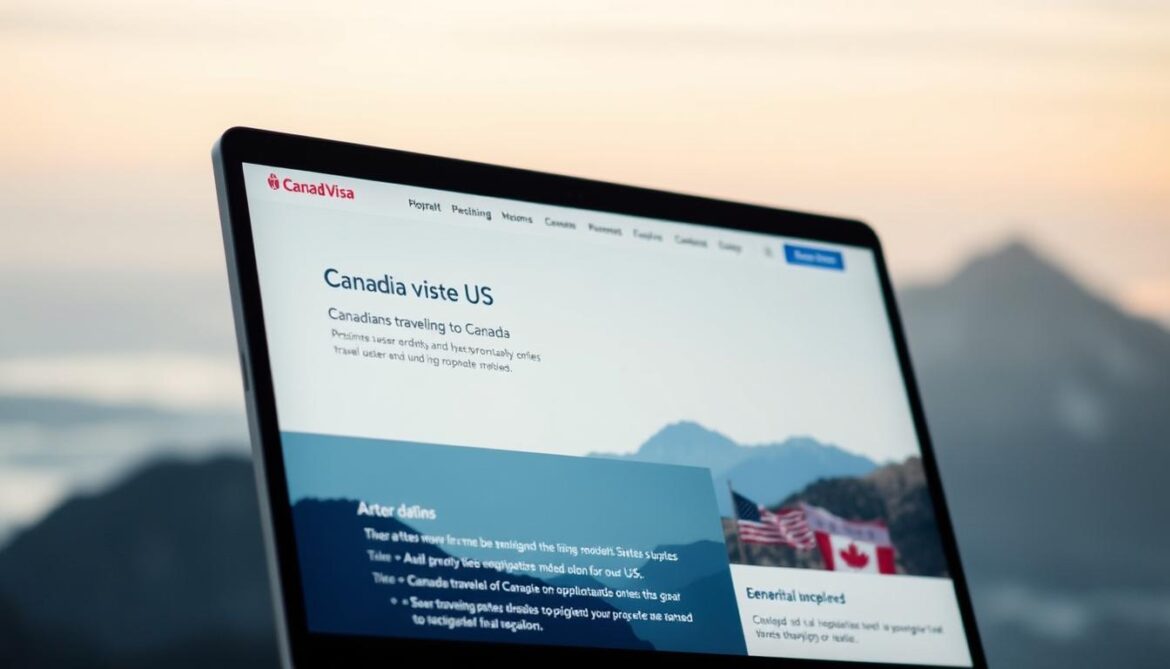Did you know over 12 million trips are made annually between Canada and the United States? Many Canadian citizens cross the border for leisure or business, but few fully understand entry rules. The Canada Visa Portal clarifies these regulations to help you travel confidently.
Under standard admission, you may visit the United States for up to 182 days per 12-month period. This applies whether you’re sightseeing, attending meetings, or visiting family. No visa is required, but U.S. Customs and Border Protection officers determine your exact permitted duration at entry.
Tracking your stay is crucial—overstaying can lead to future entry bans. New requirements also mandate registration for visits exceeding 30 days. The Canada Visa Portal provides official resources from Citizenship and Immigration Services to simplify compliance.
Ready to explore the details? Below, we break down key factors affecting your permitted duration and consequences of exceeding limits.
Introduction to US Stay Rules for Canadians
Crossing into the United States involves more than just a quick passport check. The U.S. strictly enforces entry requirements, including random electronic device searches at ports of entry. Being prepared ensures hassle-free travel.
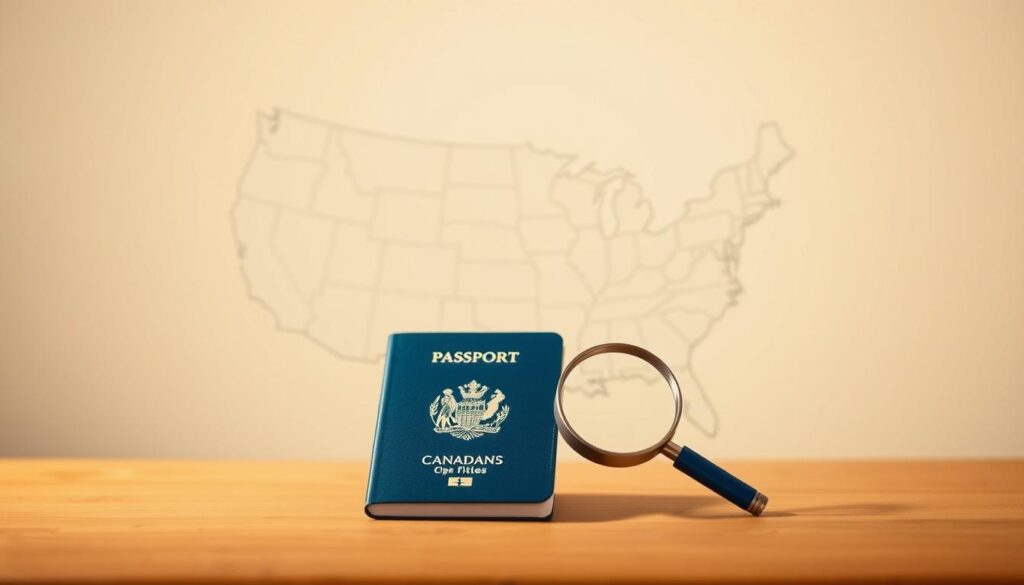
Canadian citizens enjoy visa-free access but must prove temporary visitor status. Border officers assess your ties to Canada—like employment or family—to confirm you won’t overstay.
Recent changes include:
- Documentation: Passport or NEXUS card for air travel; enhanced licenses for land/sea.
- Deemed residence: Staying too long may classify you as a U.S. resident for tax purposes.
- Mobile Passport Control app speeds up processing at major airports.
Always answer officers truthfully. Misrepresentation can lead to bans or legal action. Frequent travelers should track stays using the I-94 system.
For official updates, refer to the CBP website.
How Long Can Canadians Stay in the US?
Border officers assess each entry, but the 6-month limit applies cumulatively. Your permitted stay in the United States spans a rolling 12-month period, not a calendar year. This means frequent travellers must track total days across multiple trips.

Standard Duration Without a Visa
Canadian citizens receive up to 182 days per 12-month window. Whether you visit for *snowbird season* or a weekend getaway, U.S. Customs and Border officers verify your compliance at every entry. Business and tourism stays share the same allowance.
Short trips add up: five 10-day visits equal 50 days deducted from your limit. The I-94 travel record, available online, tracks your remaining days. Misplacing this data risks accidental overstays.
Calculating Your 6-Month Limit
Avoid common errors like resetting the clock on January 1st. The count starts the day you enter and expires 365 days later. For example:
- Single long stay: A 150-day winter visit leaves 32 days for future trips within that year.
- Multiple entries: Two 90-day stays within 12 months exceed the limit by 2 days.
COVID-era exceptions expired in 2023. Now, all days count toward your total—even if split across land and air entries. Proactive travellers use the CBP’s I-94 calculator to avoid penalties.
Entry Requirements for Canadian Citizens
Understanding U.S. entry rules ensures smooth travel for Canadian passport holders. Whether arriving by air, land, or water, you must present WHTI-compliant documents at ports of entry. U.S. Customs and Border Protection (CBP) officers enforce these requirements strictly.
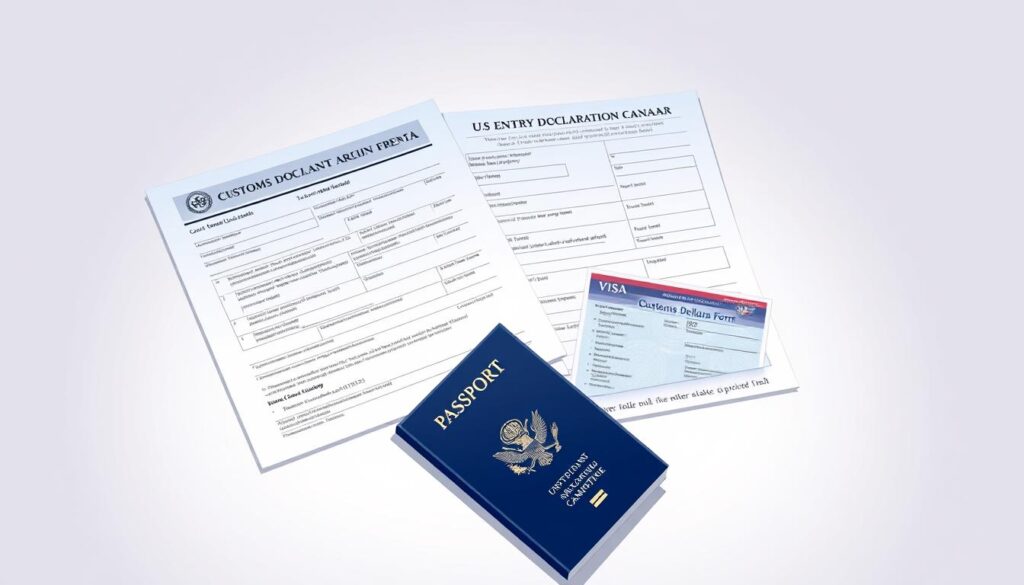
Travel by Air: Passport and NEXUS
Air travel mandates a valid passport or NEXUS card. Children under 16 may use a birth certificate. The NEXUS program expedites screening but requires pre-approval.
“All travelers must declare their purpose of visit and duration to CBP officers upon arrival.”
Travel by Land or Water: Enhanced Documents
Land and marine entries accept:
- Enhanced Driver’s Licenses (EDL) or Enhanced ID Cards.
- Trusted Traveler Program cards (e.g., FAST for commercial drivers).
- Emergency travel documents with prior approval.
| Document Type | Accepted For | Exceptions |
|---|---|---|
| Passport | All entries | None |
| NEXUS | Air/land | Not valid for marine travel |
| EDL | Land/water | Not valid for air travel |
Digital nomads should check citizenship immigration rules for extended stays. Always verify COVID-19 updates before departure.
The Alien Registration Requirement
Many travellers are unaware of U.S. alien registration requirement rules affecting Canadian visitors. Under Section 262 of the Immigration and Nationality Act (INA), certain individuals must register with immigration services after entering the United States.
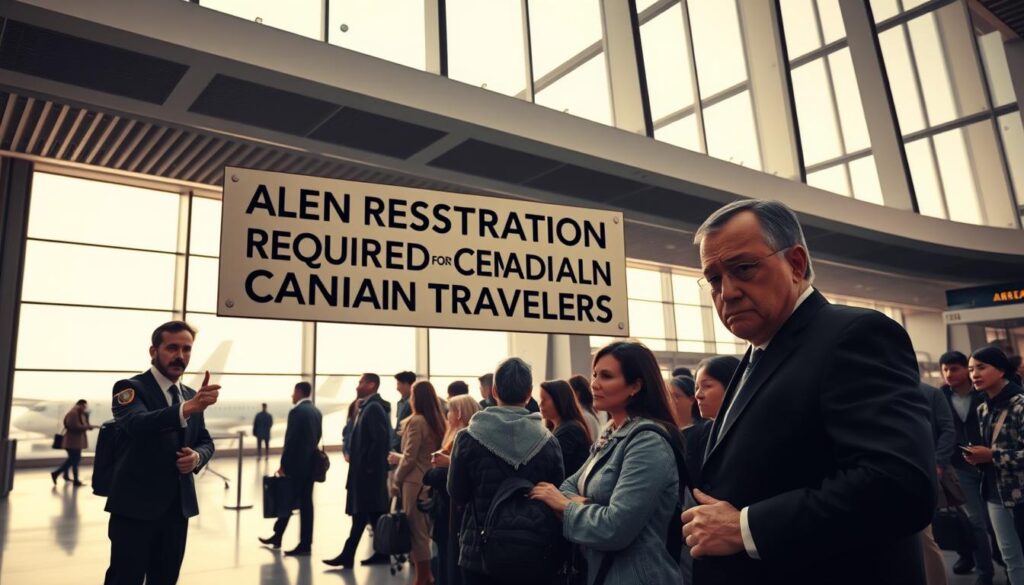
Who Needs to Register?
Mandatory registration applies if you stay beyond 30 days. Most Canadians are automatically registered via the I-94 system upon arrival. However, exceptions exist for:
- Dual citizens with U.S. nationality.
- First Nations members under Jay Treaty rights.
- Those entering by land for short visits.
Exemptions for Canadian Citizens
Not all travellers face this requirement. You’re exempt if you:
- Hold a valid U.S. green card or student visa.
- Are a frequent border crosser (e.g., NEXUS users).
- Stay fewer than 30 days consecutively.
Changes of address or extended stays require updates via the USCIS online portal. Non-compliance risks penalties, including future entry bans.
How to Check Your I-94 Status
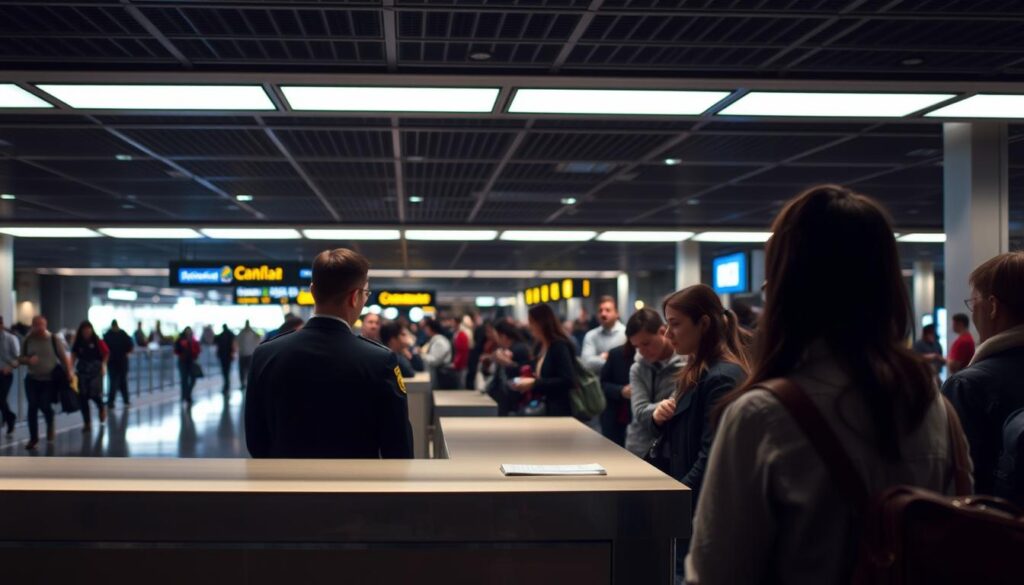
Keeping track of your U.S. travel history is easier than you think with the I-94 system. This official record, managed by U.S. Customs and Border Protection, serves as evidence of your legal entry and authorized stay duration.
Follow these steps to verify your status:
- Visit the CBP’s I-94 website and enter your passport details.
- Review the displayed entry date, admitted-until date, and visa class.
- Save or print the page for your records—border officers may request it.
Common errors include mistyping passport numbers or selecting the wrong issuing country. Double-check your entries to avoid discrepancies. If your record is missing or incorrect, contact U.S. Customs and Border Protection immediately.
“The I-94 is your proof of lawful admission. Always verify its accuracy before leaving the port of entry.”
Frequent travelers should monitor cumulative days to prevent accidental overstays. Third-party apps sync with the I-94 system but rely on official data. For historical records, submit a FOIA request via the CBP website.
Remember: Your I-94 governs compliance with citizenship immigration rules. Proactive checks simplify future crossings and reduce processing delays.
Registering with USCIS: A Step-by-Step Guide
Navigating U.S. registration processes doesn’t have to be complicated. The U.S. Citizenship and Immigration (USCIS) portal offers a free, streamlined process for compliance. Whether you’re a frequent traveler or planning an extended visit, this guide ensures you meet government requirements.
Creating a USCIS Online Account
Start by gathering required documents. The website requires:
- A valid passport and recent digital photo (2×2 inches).
- Proof of biometric exemption, if applicable.
- Payment method for optional services (e.g., expedited processing).
Mobile users benefit from optimized forms, while desktop versions offer full language support. Privacy measures encrypt your data during submission.
Submitting Your Registration
Upload documents and review entries carefully. Errors delay registration. Confirmation receipts arrive via email within 48 hours.
“Accurate submissions reduce processing times and avoid legal complications.”
Track your application online. Typical process takes 2–4 weeks. For urgent cases, contact USCIS directly.
Consequences of Overstaying or Non-Registration
Ignoring U.S. immigration rules can trigger serious legal consequences for Canadian visitors. Willful violations, such as exceeding your permitted duration or skipping registration, draw strict enforcement from border authorities. Even accidental overstays may lead to penalties that disrupt future travel plans.
Civil and Criminal Penalties
Overstaying by more than 180 days risks a 3-year re-entry ban. Beyond 365 days, the ban extends to 10 years. Fines start at $250 per day of unauthorized stay, capped at $3,000—but courts may impose higher amounts for repeat offenses.
A criminal record may result from deliberate non-compliance. Some states add jail time for fraudulent entry documents. Employers receiving your I-9 form could terminate employment if flagged by Immigration and Customs Enforcement (ICE).
| Violation | Penalty | Appeal Options |
|---|---|---|
| Overstay 1–180 days | 3-year ban | Waiver eligible after 1 year |
| Overstay 181+ days | 10-year ban | Extreme hardship waiver |
| False documentation | Felony charge | Plea bargain possible |
Impact on Future Travel
Future entry denials apply not just to the United States but may affect visa approvals for allies like Australia or the UK. Global Entry and NEXUS memberships face automatic revocation after overstays.
Family members applying for U.S. visas could undergo extra scrutiny. If misclassified as a permanent resident, you might owe back taxes. Always verify your I-94 record before departing to avoid errors.
“Penalties escalate rapidly for repeat offenders. Early consultation with an immigration lawyer minimizes long-term risks.”
Special Cases and Exemptions
Unique travel circumstances may alter standard entry rules for some visitors. While most follow the 182-day limit, certain groups qualify for exceptions under U.S. and Canadian agreements.
Dual Citizens and Permanent Residents
Green card holders (permanent residents) face different rules. You must carry your U.S. residency card when crossing. Dual citizens should:
- Declare both nationalities at ports of entry.
- Check tax obligations in both states.
- Carry passports from each country.
Military families often receive expedited processing. Consular services help resolve documentation gaps.
First Nations and Native Americans
Section 289 of the Immigration and Nationality Act (INA) grants exemptions for Indigenous peoples. Valid tribal IDs replace passports at land ports. Key rights include:
- Unrestricted cross-border employment under Jay Treaty terms.
- Family reunification without standard visa requirements.
- Blood quantum documentation for ancestral claims.
“Treaty rights ensure seamless movement for Indigenous communities. Always verify current protocols before travel.”
Extending Your Stay Beyond 6 Months
Need more time in the U.S.? There are legal ways to extend your visit. The process requires submitting Form I-539 to U.S. Citizenship and Immigration Services before your initial authorized duration expires.
- Compelling reasons like medical treatment or family emergencies
- Financial capacity to support yourself without working
- Maintained ties to Canada ensuring your return
Premium processing ($1,440 fee) cuts decision times to 15 calendar days. Standard applications take 4-6 months. Always include:
- Copy of your I-94 arrival record
- Proof of health insurance coverage
- Bank statements showing sufficient funds
“Extensions aren’t automatic. Prepare for interviews where officers verify your circumstances.”
COVID-19 exceptions expired in 2023, but precedents may help cases involving:
- Flight cancellations due to health crises
- Visa processing delays at consulates
- Quarantine requirements extending stays
Changed your plans? Those marrying U.S. citizens or starting studies may apply for status adjustments separately. Consult an immigration lawyer if denied—appeals must file within 30 days.
Travel Tips for Canadian Visitors
Smart preparation makes border crossings faster and stress-free for Canadian travelers. Whether visiting for business or pleasure, knowing U.S. Customs and Border protocols saves time and avoids delays.
Border Crossing Best Practices
Pack essentials separately for quick inspection. Declare all items, including:
- Currency over $10,000 CAD (mandatory reporting).
- Prescription medications in original containers.
- Pet vaccinations records for animals.
RVs and boats require additional documentation. Check agricultural restrictions below:
| Item | Restriction | Penalty |
|---|---|---|
| Fresh fruits | Prohibited | $300+ fine |
| Firewood | Banned | Confiscation |
| Dairy products | Limited to 20 kg | Disposal |
Handling Electronic Device Searches
U.S. Customs and Border officers may request access to phones or laptops without cause. Protect your data:
- Back up sensitive files to secure cloud storage.
- Disable auto-connect to border Wi-Fi networks.
- Know your rights during secondary inspections.
“Travelers must provide passwords if asked. Refusal may lead to device confiscation or entry denial.”
Encrypted devices? Declare them upfront. Officers document searches but cannot copy data without evidence of wrongdoing.
Conclusion
Staying compliant ensures smooth future travels across the border. Track your visits using the I-94 system to avoid exceeding the 182-day limit.
Canadian citizens benefit from visa-free entry but must prove temporary visitor status. Seasonal travelers should note peak enforcement periods.
Review the requirements on official websites like CBP or USCIS. Compliance prevents bans and speeds up processing.
Bookmark the Canada Visa Portal for updates. Need help? Consult an immigration expert for personalized advice.


